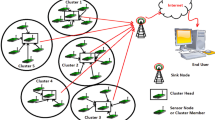Abstract
In the wireless sensor network (WSN), nodes show a low forwarding rate under a poor-quality links environment and a resource-constrained state. The malicious nodes imitate this forwarding behavior, which can selectively forward date, eavesdropping, or discarding important dates. The traditional reputation model is challenging to identify with this kind of sub-attack nodes. To address these problems, a malicious node identification strategy based on time reputation model and environmental parameters optimization (TRM-EPO) is proposed in the WSN. First of all, the comprehensive reputation is calculated according to the direct reputation and the recommended indirect reputation. The environmental parameters matrix is based on nodes’ running state, taking into account nodes’ energy, data volume, number of adjacent nodes, and node sparsity. Besides, according to the environmental parameters matrix, and the recorded comprehensive reputation matrix, the next cycle’s trust can be predicted. Finally, a similarity of the actual reputation and predicted trust matrix is proposed to compare with an adaptive threshold to identify malicious nodes. The experimental results demonstrate that the proposed strategy improves sensor nodes’ security and reliability in a complex environment. Moreover, compared to comparison algorithms, the TRM-EPO improves the recognition rate above 1% and reduces the false-positive rate by more than 1%.










Similar content being viewed by others
References
Sahoo, R. R., Ray, S., Sarkar, S., et al. (2018). Guard against trust management vulnerabilities in wireless sensor network. Arabian Journal for Science and Engineering, 43(12), 7229–7251.
Jin, X., Liang, J., Tong, W., et al. (2017). Multi-agent trust-based intrusion detection scheme for wireless sensor networks. Computers and Electrical Engineering, 59, 262–273.
Bao, F., Chen, I. R., Chang, M. J., et al. (2012). Hierarchical trust management for wireless sensor networks and its applications to trust-based routing and intrusion detection. IEEE Transactions on Network and Service Management, 9(2), 169–183.
Feng, R., Han, X., Liu, Q., et al. (2015). A credible bayesian-based trust management scheme for wireless sensor networks. International Journal of Distributed Sensor Networks, 11(11), 1–9.
Osanaiye, O., Alfa, A. S., & Hancke, G. P. (2018). Denial of service (DoS) defence for resource availability in wireless sensor networks. IEEE Access, 6, 6975–7004.
Siddiqui, S., Ghani, S., & Khan, A. A. (2018). PD-MAC: Design and implementation of polling distribution-MAC for improving energy efficiency of wireless sensor networks. International Journal of Wireless Information Networks, 25(1), 1–9.
Elshrkawey, M., Elsherif, S. M., & Elsayed Wahed, M. (2018). An enhancement approach for reducing the energy consumption in wireless sensor networks. Journal of King Saud University-Computer and Information Sciences, 30(2), 259–267.
Zawaideh, F., & Salamah, M. (2019). An efficient weighted trust-based malicious node detection scheme for wireless sensor networks. International Journal of Communication Systems, 32(3), 1–13.
Ganeriwal, S., & Srivastava, M. (2004). Reputation-based framework for high integrity sensor networks. In Proceeding of the 2nd ACM workshop on security of ad hoc and sensor networks (SASN’04), New York, USA, ACM (pp. 66–77).
Ishmanov, F., Kim, S. W., et al. (2015). A robust trust establishment scheme for wireless sensor networks. Sensors (Basel, Switzerland), 15(3), 7040–7061.
Xi, O., Bin, T., Dong, L., et al. (2012). A novel hierarchical reputation model for wireless sensor networks. International Journal of Digital Content Technology and its Applications, 6(10), 61–69.
Zhang, L., Yin, N., & Wang, R. (2015). Research of malicious nodes identification based on DPAM-DM algorithm for WSN. Journal on Communications, 36(S1), 53–59.
Fu, J. S., & Liu, Y. (2015). Double cluster heads model for secure and accurate data fusion in wireless sensor networks. Sensors, 15(1), 2021–2040.
Zhang, Z., Zhu, H., Luo, S., et al. (2017). Intrusion detection based on state context and hierarchical trust in wireless sensor networks. IEEE Access, 5(99), 12088–12102.
Ting, H., Shoushan, L., Yang, X., et al. (2013). Dynamic trust model with multiple decision factors in MANET. Journal of Beijing University of Posts and Telecommunications, 36(5), 104–109.
Ram Prabha, V., & Latha, P. (2017). Fuzzy trust protocol for malicious node detection in wireless sensor networks. Wireless Personal Communications, 94(4), 2549–2559.
Teng, Z., Guo, L., Lv, J., et al. (2019). WSN bayes reputation evaluation model based on time series information analysis. Journal of Zhengzhou University (Engineering Science), 40(1), 38–43.
Heinzelman, W. R., Chandrakasan, A., & Balakrishnan, H. (2000). Energy-efficient communication protocol for wireless microsensor networks. In Proceedings of the 3rd annual Hawaii international conference on system sciences (HICSS’00), Hawaii, USA (pp. 1–10).
Li, Y., Yu, J., & You, X. (2013). An incentive protocol for opportunistic networks with resources constraint. Chinese Journal of Computers, 36(05), 947–956.
Yu, Y., Li, K., Zhou, W., et al. (2012). Trust mechanisms in wireless sensor networks: Attack analysis and countermeasures. Journal of Network and Computer Applications, 35(3), 867–880.
Li, P., Shi, Z., & Liu, X. (2018). Application of fuzzy C-means clustering algorithm based on immune genetic algorithm. Journal of Northeast Electric Power University, 38(3), 79–83.
Kumar, G. E. P., Titus, I., & Thekkekara, S. I. (2012). A comprehensive overview on application of trust and reputation in wireless sensor network. Procedia Engineering, 38, 2903–2912.
Acknowledgements
The authors would like to thank the anonymous reviewers for their valuable comments and suggestions to improve this paper. Besides, this work is supported by the National Natural Science Foundation Youth Science Foundation Project (No. 61501107), “13th Five-Year” Scientific Research Planning Project of Jilin Province Department of Education (No. JJKH20180439KJ).
Author information
Authors and Affiliations
Corresponding author
Additional information
Publisher's Note
Springer Nature remains neutral with regard to jurisdictional claims in published maps and institutional affiliations.
Rights and permissions
About this article
Cite this article
Teng, Z., Pang, B., Sun, M. et al. A Malicious Node Identification Strategy with Environmental Parameters Optimization in Wireless Sensor Network. Wireless Pers Commun 117, 1143–1162 (2021). https://doi.org/10.1007/s11277-020-07915-w
Accepted:
Published:
Issue Date:
DOI: https://doi.org/10.1007/s11277-020-07915-w




